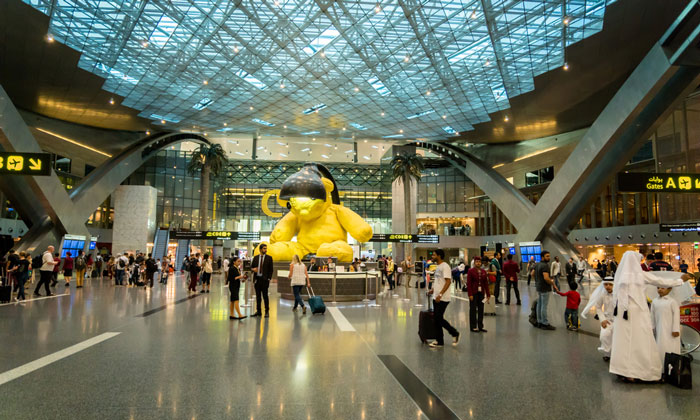Hamad International Airport: Uncovering the world’s leading smart airport
- Like
- Digg
- Del
- Tumblr
- VKontakte
- Buffer
- Love This
- Odnoklassniki
- Meneame
- Blogger
- Amazon
- Yahoo Mail
- Gmail
- AOL
- Newsvine
- HackerNews
- Evernote
- MySpace
- Mail.ru
- Viadeo
- Line
- Comments
- Yummly
- SMS
- Viber
- Telegram
- Subscribe
- Skype
- Facebook Messenger
- Kakao
- LiveJournal
- Yammer
- Edgar
- Fintel
- Mix
- Instapaper
- Copy Link
Posted: 15 August 2017 | Eng. Badr Al Meer | COO | Hamad International Airport, Roy Manuell | Junior Editor | 1 comment
Hamad International Airport (HIA), 6th in the SKYTRAX rankings, is widely considered one of the world’s most exciting airports and off the back of an announcement of new collaboration with Huawei, International Airport Review speaks to COO Eng. Badr Al Meer.


Hi Badr, could you give us a little more detail regarding the deal Hamad International Airport has just signed with Huawei?
The Memorandum of Understanding (MoU) we have signed with Huawei provides a framework for cooperation in exploring opportunities for accelerating the digital transformation at HIA. The scope includes trials of some specialised solutions of interest to HIA and core IT infrastructure technologies. This is not a purchase deal; as all our purchases are through competitive procurement processes based on viable business cases.
So many things in common
We recognised that both parties share key attributes: we are known for being state-of-the-art and for our focus on technology-enabled innovation; Huawei has an overall focus on innovation; and in fact invests a very substantial portion (in USD billions) of their annual revenue in research and development.
It was these shared attributes and Huawei’s keen interest that ultimately led our airport into partnering with them. We wanted to re-evaluate the existing infrastructure and systems to ensure that we continue to develop technology to support our ambition of being one of the most customer-centric and efficient airports in the world; and believe that the cooperation with Huawei will help us establish a better understanding and roadmap.
As you know, technology is always changing. We acknowledge the need to change with it. Even though we are young, we are not afraid to upgrade existing assets and infrastructure and you can see this in our investment in security technology and advanced screening systems.
So there is a degree of trust in the relationship. You are almost placing your faith in Huawei to act on your behalf?
It’s not quite a question of them acting on our behalf. It’s more of a cooperation and team effort. We respect their expertise and wish to work with this knowledge to ensure our airport remains one of the best in the world.
Could you tell us a bit more about the concept of a ‘smart’ airport? What does this mean to you?
A smart airport, as you can see at Hamad International Airport, is about taking the passenger on a memorable journey and experience.
We are incidentally one of the first world airports to concurrently implement self-service capability at scale on all passenger touch points which we are achieving in collaboration with IATA and ACI.
Our idea is to offer our passengers supreme control over their time and journey from the moment they enter the airport to the moment they are seated on the aircraft, in essence, without any human interaction.
We have learned through passenger research that immigration and security touch points are where tension levels increase among passengers as they are unsure of the amount of time they have, how long screening will take, the precise documents required in a foreign country etc.
By empowering them – allowing them to conduct their own processes by giving passengers all the information and autonomy they require- we can reduce stress levels and save time. Tension rises when we, as individuals, don’t have control over what we are doing. The smart airport program gives control back to the passenger.
The smart airport gives control back to the passenger.
So at what stage is Hamad International Airport at present?
This is just phase 1 of the smart airport program.
Phase 1 covers self-service capability for check-in, bag-drop, pre-border control and border control checks, as well as the HIA mobile application that replaces information desks and customer information points. The app can tell you what your gate number is, precisely how far your gate is, the time it would take to reach your gate and so on. The app can also send alerts/ notifications on shopping/dining special offers and flight status so that it becomes difficult to miss your flight.
Once again this is just phase 1.
Phase 2, already underway, will focus on facial recognition and will link passenger biometric data to the boarding pass and passport during the check-in process. This is single token travel and will ensure that all processes are based on biometric recognition.
This phase will also cover smart security checkpoints, as proposed by IATA, and mass scale deployment of automated boarding gates; where you would simply have to scan your boarding pass and biometrics will take control of the identification process. This will further eliminate the need for human interaction.
So how soon will this all be implemented?
Well, as discussed, the smart airport concept is already underway and being implemented as we speak and began around a year ago.
We are always trialling new concepts and reviewing those in place to ensure that all areas are fit for purpose. Once we were content with the product for the initial launch, HIA went public with the smart airport program around 6 months ago and we are now increasing the scale.
Phase 2 is a little trickier. The installation of cameras and equipment itself is relatively easy; however the rollout is complicated because we need to ensure that all parties- the airport, airlines, and government agencies – agree to common standards, particularly regarding biometrics; share the relevant data; agree on seamless process for handling exceptions; and in general are on the same page.
All aspects including the security and immigration processes need to be optimised by all parties sharing and utilising the same data. Essentially, we all have the same end goal and deadline.
Given the fact that your relationship with Qatar Airways is very healthy, do you regard yourself as a model for the rest of the world to copy?
Our good relationship is not exclusive to Qatar Airways. Hamad International Airport enjoys a healthy relationship with all parties: be it airlines, regulators or suppliers. At the end of the day, we all share the same goal and we all work toward the same aim.
We all share the same goal and we all work toward the same aim.
Not only this but we use other airports as models and take influence from around the world. Airports in this business for a number of years, Changi, Incheon, Hong Kong and many more for example, themselves act as benchmarks for Hamad International Airport.
3 years ago, we were realistic and did not aim to compare ourselves to Changi, Incheon or Hong Kong. Let’s be grounded, I said, and aim for Heathrow, Schiphol, Zurich, Munich and the European leaders. We have since exceeded our own targets. Now, after the sheer extent of our progress, I am proud to state that we can compete with any airport. Our next target is to emulate the Asian superpowers.
And the idea of the airport as a destination in itself?
We often think of an airport as a transitional place; a place to move through as quickly as possible before sitting on the plane. Hamad International Airport aims to change this. Once you step into the main section of the terminal, you can see various art installations like the giant yellow bear, as well as children’s playgrounds, TV and computer areas, family rooms and much more. We want passenger experience in the airport to be unique and enjoyable – not a place to rush through. Our airport is an innovative space and we have hosted magic shows, orchestral performances and fashion shows in the past. We aim to provide something for everyone at Hamad International Airport.
Our airport is an innovative space
And finally, talking about expansion, what can you tell us about developing Hamad International Airport in this way?
With Qatar Airways signing deal after deal for new aircraft and expanding its fleet, we need to ensure that Hamad International Airport keeps up with this demand for capacity. The decision to expand was part of the government’s 2030 vision that spans the entire nation. The airport is just a part of this.
We are currently considering two designs and while I cannot elaborate on these in too much detail, both have pros and cons and the decision will be made by the end of this year. The plans are ready so expect news coming very soon.
It is clear from speaking to COO Eng. Badr Al Meer that Hamad International Airport is an extremely exciting place to be, driving innovation and moving forward with unparalleled ambition further into the 21st Century. Much like Dubai and many of the other Middle Eastern superpowers, the technology implemented in these ultra-modern hubs is phenomenal. But as Badr asserted, as technology changes, it is imperative that we change with it.
Related topics
Aeronautical revenue, Airport construction and design, Airport development, Airside operations, Border control, Capacity, Economy, Information technology (IT), New technologies, Passenger experience and seamless travel, Passenger volumes, Security, Sustainable development, Terminal operations



















Very interesting article. It is great to see where airport technology is moving. I just booked a airline ticket – we could use some smart technology in that arena as well 🙂
Alexa